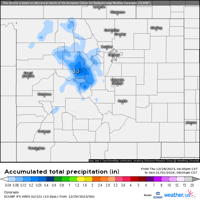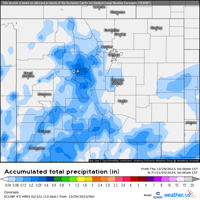Whiteout daily snow report, Dec. 29
Very little change to the forecast for Friday as Colorado sits under high pressure and storms are nowhere to be seen.
The mercury doesn’t appear to climb above 32 degrees however, with highs climbing toward the upper 20s and a continued low sun angle. This trend will continue through the weekend and into the new year.

A Weather.us forecast model shows the potential accumulation levels of water-equivalent precipitation as of 8 a.m. Monday, Jan. 1 for Colorado. Depending on the density of the snow, one inch of water is equivalent to 10 inches of snow based on a common rule of thumb ratio of 10:1.
Weather.us

A Weather.us forecast model shows the potential accumulation levels of water-equivalent precipitation as of 8 a.m. Monday, Jan. 1 for Colorado. Depending on the density of the snow, one inch of water is equivalent to 10 inches of snow based on a common rule of thumb ratio of 10:1.
The ECMWF model has trickles of snow possible on Sunday and New Years Day, Monday for the north-central mountains (Copper, Cooper, Vail and Beaver Creek), but low accumulation amounts of less than 2 inches total by New Years Day sunset are about it.
The dry weather is forecast to stick around until around Jan. 4 or 5 when a storm grazes southern Colorado’s mountains. The storm track follows a line across northern New Mexico and could drop the majority of precipitation in Arizona and New Mexico, but snow showers appear to be more widespread south of I-70 for Jan. 5 morning.

A Weather.us forecast model shows the potential accumulation levels of water-equivalent precipitation as of 6 a.m. Friday, Jan. 5 for Colorado. Depending on the density of the snow, one inch of water is equivalent to 10 inches of snow based on a common rule of thumb ratio of 10:1.
Weather.us

A Weather.us forecast model shows the potential accumulation levels of water-equivalent precipitation as of 6 a.m. Friday, Jan. 5 for Colorado. Depending on the density of the snow, one inch of water is equivalent to 10 inches of snow based on a common rule of thumb ratio of 10:1.
The forecast for after Jan. 5, however, appears to favor Colorado more. From Jan. 8 to 12, a storminess period should bring snow back in a couple of waves. More details to come as the forecast models align themselves.
Of note: On Dec. 29, 2006, a second of four storms to make its mark on the Front Range and urban corridor started dropping snow from the sky.
Denver residents were still digging out from the heavy snowfall and blizzard that occurred between Dec. 20-21, as the second major winter storm in a week buried the city and the eastern foothills again in more deep snow. Heavy snowfall ranged from 1-2.5 feet in the foothills and from 6-18 inches across the city. Another slow moving storm system centered over the Texas panhandle produced deep upslope flow over the high plains and against the Front Range Mountains.
In the foothills west of Denver, the snow fell at a rate of three to four inches an hour at times. Total snowfall in the foothills included: 30 inches near Genesee; 29.5 inches 12 miles northwest of Golden; 25 inches in Evergreen and near Bergen Park; 24 inches near Conifer; 23.5 inches 3 miles southwest of Golden and near Gold Hill; 23 inches near Jamestown; 22.5 inches in Rollinsville; 19.5 inches in Aspen Springs; 19 inches near Blackhawk; 18.5 inches at Nederland; 16 inches in Indian Hills, at Intercanyon, and in Eldora; 15.5 inches at Echo Lake; and 12 inches near Ralston Reservoir.
Today’s 24 hour snow total from Colorado resorts:
Arapahoe Basin – 0″
Aspen Mountain – 0″
Aspen Highlands – 0″
Beaver Creek – 0″
Breckenridge – 0″
Buttermilk – 0″
Cooper – 0″
Copper Mountain – 0″
Crested Butte – 0″
Echo Mountain – 0″
Eldora Mountain – 0″
Granby Ranch – 0″
Hesperus – Closed for season
Howelsen Hill – 0″
Kendall Mountain – 0″, open weekends
Keystone – 0″
Loveland – 0″
Monarch – 0″
Powderhorn – 0″
Purgatory – 0
Silverton – 0″
Snowmass – 0″
Steamboat – 0″
Sunlight – 0″
Telluride – 0″
Vail – 0″
Winter Park – 0″
Wolf Creek – 0″






